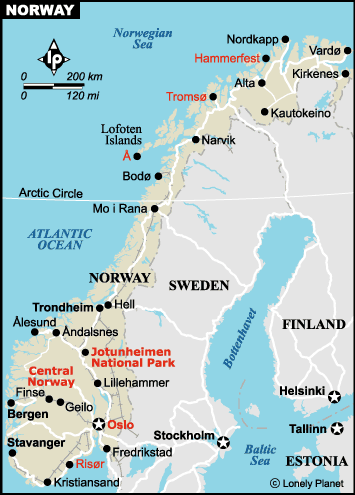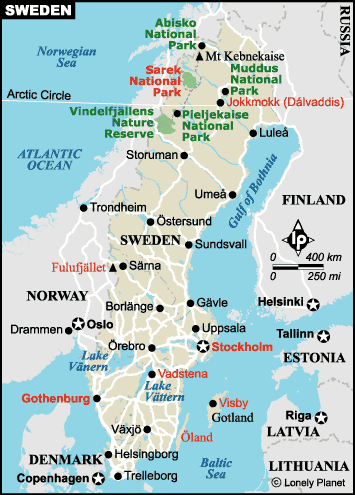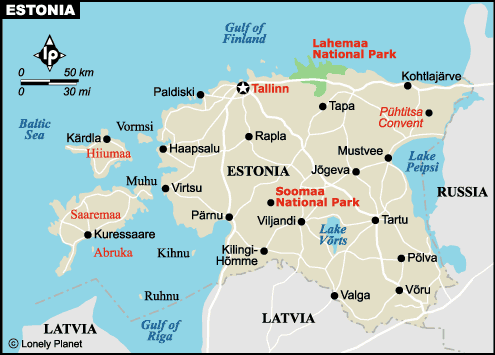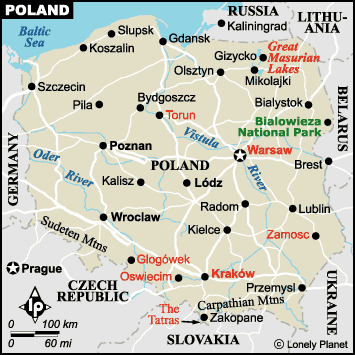Presentation of the trip
The first gallop of test in
North and West Africa
marked the truck by breakdowns and damage which has being repaired by MAN as
well as by UNICAT. For this intention it was immobilized from April 12 to
June 02 at Bourg-en-Bresse then at Dettenheim in Germany.
During May, I remained at the Backoffice in Var where I prepared the
trip to the Northern and Eastern Europe.
This second gallop of test will visit the four Scandinavian countries, the
three Baltic States, Poland and previous Czechoslovakia. The return towards
France should be made by crossing Germany. It will be held over
three months and will travel nearly 20,000 km.
This page briefly give some information about the crossed countries. The event-driven history
of the trip is report by travelog pages published, according to
mood, with the liking of discovered cybercafés.
La Scandinavie
Scandinavia covers two
geographical meanings:
-- Stricto sensu, it corresponds to septentrional Europe made up of
Norway and Sweden shaping the Scandinavian peninsula to which Denmark is
attached to constitute a cultural and linguistic unit. These countries were
linked by the treaty of Kalmar in 1397. The three current monarchies have as
ancestor the Marshal of Empire Jean-Baptist Bernadotte.
-- Lato sensu, it includes Finland and sometimes even Iceland. Since 2001,
the experience of the "Schengen agreement" were widened with the members of the
Scandinavian Union - Scandinavia lato sensu -.
Except Iceland, the four Scandinavian countries constitute a homogeneous
set of landscapes and climate.
The way of approach crosses Belgium, Holland and Germany to arrive at the
border of Denmark.

In the extreme north of Germany, Denmark includes a continental
part, Jutland, and islands of which the most important are Fyn, Sjaelland and
Laaland.
The peninsula of Jutland is breeding and cultures ground.
Maritime power since the origin of times, it took part in the Viking age,
indifferently Norwegian, Swedish or Danish.
The history of this small country is abundant in high feats of arms ensuring
its perenniality. It explains its subsidiary position in the European Union.

Norway occupies the Atlantic coastline of the Scandinavian peninsula which
stretches on 1,800 km from the south to the north. The Norwegian coast is shredded
by many fjords making the landscapes very dramatic and it is bordered by
islands of which the most known are Lofoten and Vesteralen.
The Norwegian coast bathed by the Gulf Stream offers a mild climate
during the summer season favourable with the tourist trip.
Only 3% of surface consist of arable land.
The exploitation of the crude oil ensures the kingdom of comfortable
incomes; combined with its political neutrality consolidated it in its
touchy individualism.

Sweden is the eastern part of the Scandinavian peninsula on the Gulf
of Bothnia and the Baltic. The Swedish coast is cut out by fjords with in
the south the islands Öland and Gotland.
The interior landscape consists of cut plains by rivers and lakes suitable
with the picturesque trip.
Its economic success and its social model were the reference in the Western
Europe during long decades. Like Denmark, Sweden takes subsidiary part in the European Union.

Finland belongs to the north-eastern part of the European continent. The
western coast is on the Gulf of Bothnia, the Baltic, and the gulf of
Finland. The interior of the country makes up of wooded hills and thousands
of lakes.
The forest of pine and birch covers two thirds of the Finnish territory.
Finland tardily became independent after the Russian revolution of October
1917. It fis integral part of the European Union.
The Baltic States
The Baltic States gather three
countries in the east of the Baltic: Estonia, Latvia, Lithuania. Their
history was very animated during centuries. They recovered their
independence after the fall of the USSR in 1991. Then they integrated the
European Union in 2003, the participation in the monetary Union is envisaged
in 2007.
Between Lithuania and Poland, the enclave of Kaliningrad - ex Königsberg of
the Eastern Prussia is part of the Russian State.

Estonia is the most septentrional and the smallest of the Baltic States. In the
west at sea the Baltic, two islands, Saaremaa and Hiiumaa, accounts for 10%
of its territory. It has two continental borders with Russia in the east and
Latvia in the south.
Of flat conformation, it has an average altitude of 200m covered by a half
by forests and by a quarter by peat bogs.
The Estonian is not an Indo-European language, it belongs to the Finno-Ugric
group to which Finnish and Hungarian belong.

Latvia is the Baltic country in the middle, larger than
its northern neighbour and smaller than that in the south.
Its average altitude is also low, approximately 200m. It is covered by
forests and peat bogs. It shelters the strongest colony of storks in Europe.
The history of Latvia is inseparable of Teutonic Knights.

Lithuania is the southernmost and the largest of the three Baltic countries. Located
mainly in the basin of Niémen, its average altitude is of 250m.
The many national parks are biotopes of rare species.
The history of Lithuania is inseparable of that of Poland from which it
adopted during decades language and culture.
The Eastern European countries
The trip in the Northern Europe ends in the return towards France by visiting Poland, Czech and if possible Slovakia. These three countries occupy the Western Carpates partly.

Bridge between the Western Europe and the Eastern Europe, Poland played a great
part in the history of the Central Europe. From the XIXth century its borders
were the stake of the competitions between its powerful neighbours.
Poland covered its independence in 1989. It joined the European Union in
2004.
The northern and central part of Poland is relatively flat and constitutes
the loftcorn of the country. The south is bordered by mountains, Sudetes in the
west and Carpates in the east - Tatras -.
The
Polish belongs to the Slavic group of the Indo-European languages. He has
eight vowels and thirty six consonants.

Czech, more usually called Czech Republic, results from
the scission of Czechoslovakia in 1993. It is composed of Bohemia, Moravia
and a part of Silesia.
Country of middle mountains, it is sprinkled mainly by Elba, Moldau, Morava
and Oder.
Prague is one of the most prestigious cities of Central Europe. Its
historical centre is registered in the inheritance world of UNESCO.

Slovakia was part of old Czechoslovakia. Carpates, in arc of circle, is
the northern part of the country with Tatras. In the western south the plain
of the Danube constitutes the border with Austria. The landscapes are very
varied and very contrasted.
It is a country with the traditions well become established in its villages, its
castles and its churches of Gothic or baroque style.